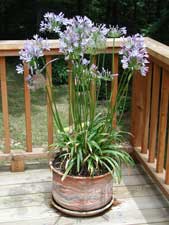Resource Library
Plant of the Week: Lily, African
The University of Arkansas System Division of Agriculture does not promote, support or recommend plants featured in "Plant of the Week." Please consult your local Extension office for plants suitable for your region.
Plant of the Week
African Lily
Latin: Agapanthus praecox
Blue is a pleasing color in the summer garden. Most blue flowered plants - delphiniums, columbines and the like - are spring bloomers but not so with the African lily, Agapanthus praecox.
This species is the most common and easily grown of the half dozen species of Agapanthus found in South Africa, where all are native. They have long been considered part of the Amaryllis family, but in recent years have been moved to their own family that contains only the one genus.
A. praecox is an evergreen species with broad, strap-shaped leaves one-half to 1 inch wide and 2 feet long. The leaves emerge from a dense tangled crown of pinkie-sized tuberous roots.
The 2 to 3 foot tall flower scapes emerge in late spring and and summer. Plants remain in flower for four to six weeks. The light- to dark-blue, violet, or occasionally white flowers are borne in dense, round umbels 4 to 6 inches across. Flower clusters may contain 100 trumpet-shaped, six-petaled florets that are individually an inch across.
Agapanthus have been cultivated in European conservatories since the 17th century, sent back by early Dutch settlers. It was originally given the name Hyacinthus Africanus tuberosus, flore caeruleo umbellata, following the naming system in vogue in those pre-Linnaean days. The name Agapantus (“agape” means love) plus (“anthos” means flower) first was used in 1788 and followed the then new Linnaean system of naming. It was first listed in the United States in 1806 and was commonly offered during the 19th century.
Name confusion is rampant, with A. africanus, A. umbellata, A. minimus and A. orientalis being frequently listed. Virtually all of the Agapanthus grown in gardens around the world are from the three naturally occurring varieties of the easily grown and adaptable A. praecox; var. orientalis, var. praecox and var. minimus.
Agapanthus praecox is from the year-round rainfall area of South Africa and is found in areas receiving 20 inches of rain each year. It is only evergreen in areas without frost and does best outdoors in areas with a Mediterranean climate. In northern climates it is primarily grown as a pot plant indoors or in a cool greenhouse. A cultivar called ‘Headbourne,’ a 1960s selection from Lewis Palmer’s garden in England, is considered the hardiest. The Headbourne cultivar dependably survives to 20 degrees F in zone 8 and occasionally in zone 7.
Where hardy, agapanthus should be grown in full sun. They are not fussy about soils but blooming will be stymied if plants are allowed to get too dry in the spring when they are beginning their growth. For container-grown plants, add one-third good garden loam with two thirds by volume of any good organic potting soil.
Tall kinds are well suited for massing or interspersing in the mixed border while more compact plants are often used for edging walkways. They are also well-suited for use in large tubs, where they make excellent additions to poolside plantings or sunny patios. Agapanthusare heavy feeders and should receive routine fertilization during the spring and summer growing season. In the winter, stop fertilizing and keep plants on the dry side.
Because agapanthus are such aggressive growers, they should be divided about every four or five years. For container-grown plants, divide in late summer after flowering. For plants grown outdoors, especially in the colder part of their range, delay division until the spring. Trim back the roots as needed to replant, taking care to keep the plant watered while it becomes re-established.
By: Gerald Klingaman, retired Extension Horticulturist - Ornamentals Extension News - August 22, 2008
The University of Arkansas System Division of Agriculture does not maintain lists of retail outlets where these plants can be purchased. Please check your local nursery or other retail outlets to ask about the availability of these plants for your growing area.
